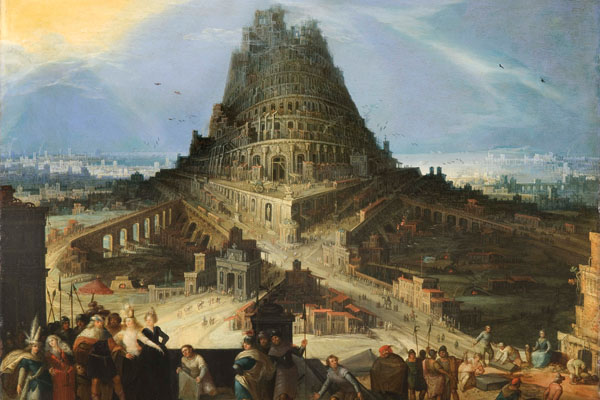If you want to see how myths arise from misunderstandings, the Tower of Babel provides a textbook example. In ancient Assyrian babilu means ‘door of God’ and thus correctly describes the Babylonian ziggurat erected to the god Marduk by Nebuchadnezzar II and later seen in ruins by Herodotus. But in Hebrew the word bâlal means ‘to confuse’, hence the confusingly different account in Genesis. In this version, men come together in the cradle of civilisation to build ‘a tower, whose top may reach unto heaven’ as a monument for posterity, lest they be ‘scattered abroad upon the
face of the whole earth’ — and God, sensing that ‘this is only the beginning of what they will do’, sends down a software bug to corrupt their communal language and scatter them before they finish the job.
It’s from this muddle that Babel emerges as the ultimate symbol of architectural hubris, a subject first represented in Flemish art in the 16th century. Early images of the tower form the high point of the exhibition of Flemish Landscape Fables just opened at the Palais des Beaux-Arts in Lille as part of a citywide arts festival on the theme ‘Fantastic’. Bringing together 100 works by Bosch and Brueghel and their followers, the show examines the curious role of fantasy in the development of the landscape genre north of the Alps.
While early Venetian landscapes idealised reality, early Flemish landscapes distorted it. To the Flemish, landscape was a blank canvas on which the artist’s imagination was free to roam. Even the father of Flemish landscape painting, Joachim Patinir, who was born in Brittany and knew what hills looked like, took fantastic liberties with geological reality. But stranger than the geological features of many of these landscapes were their flora and fauna. In Venetian landscapes we encounter the odd nymph or satyr, but in the landscapes of Bosch and his imitators we come into confrontation with mutant species without precedent even in myth.
Where on earth did these bizarre visions come from? Disregarding the diagnosis sometimes offered that the artists were suffering from the hallucinatory effects of ergot poisoning caused by mould in grain, the show’s curator Paul Vandenbroeck argues that the monstrous life forms populating Bosch’s landscapes were visual manifestations of the vice and corruption to which untamed nature is congenitally prone. To which I’m tempted to say, ‘Hmmm.’ Fair enough, his theory could account for the hatch of demons infesting Bosch’s ‘The Temptations of St Anthony’, and the grotesque minstrels adding to Jan Mandyn’s ‘Trials of Job’ by blowing a cacophony of trumpets in his ear. And I suppose it could justify the invasion of the waters round Mandyn’s ‘St Christopher’ by shoals of shape-shifting fishy fiends. But how does it explain the fact that in a Last Judgment triptych from Bosch’s workshop, heaven is almost as weird as earth or hell? Playing polo on a unicorn and relaxing by a fountain with an egret perched on one’s head is not most people’s idea of a blessed eternity, nor does the cactus-cum-eggplant growing in the foreground conform with conventional notions of Elysian botany.
Bosch fired his imaginative squibs out into the world from his hometown base of s-Hertogenbosch, but as other Flemish artists began to travel the landscapes they painted became increasingly believable and the activities they recorded increasingly human. In Herri Met de Bles’s pictures of contemporary mine workings, painted in 1544, the mining is drawn from life but the mountains invented; in Lucas van Valckenborch’s, painted 40 years later, the topography is as convincing as the human activity. Fires that formerly lit up the skies over Sodom and Gomorrah or raged behind the tempted St Anthony were now contained in brick-built furnaces for the practical purposes of
smelting.
In the Babel paintings that close the show, the practical and the fantastic are woven together. All four compositions are clearly indebted to Pieter Brueghel’s seminal image of 1563, itself inspired by the ruins of the Colosseum, but the closest in date and mood is the version by Hendrick van Cleve who, like Brueghel, made the journey to Rome. In later, stormier views by Joos de Momper and Tobias Verhaecht the unfinished tower seems already to be crumbling, but van Cleve’s sunlit Babel is very much under construction, crawling with miniature builders working treadwheel cranes, melting bitumen and firing bricks, while in the foreground a cringing architect presents his plans to an imperious Nebuchadnezzar.
Brueghel’s tower is not included (the Brueghel of the show’s title is Jan the Elder) but a blown-up reproduction hangs downstairs at the entrance to a contemporary exhibition on the theme of BABEL, where Yang Yongliang’s digital manipulations of Shanghai skyscrapers into mountain landscapes butt up against Anselm Kiefer’s ‘Fertile Crescent’ paintings, seemingly built like Nebuchadnezzar’s ziggurat out of mud. The image of Babel has retained its symbolic power, but in the realm of pure fantasy something has been lost. What contemporary artist can compete with Bosch? Ergot poisoning may not have been such a bad thing.






Comments